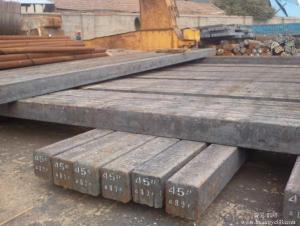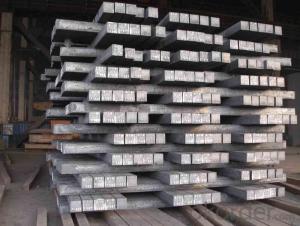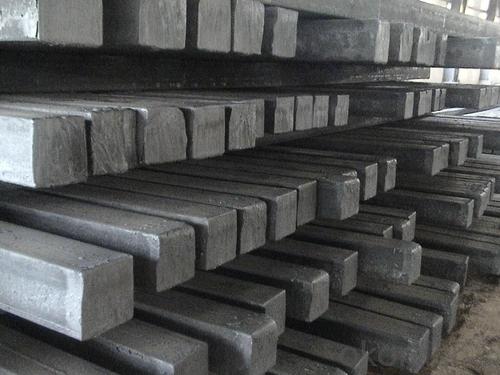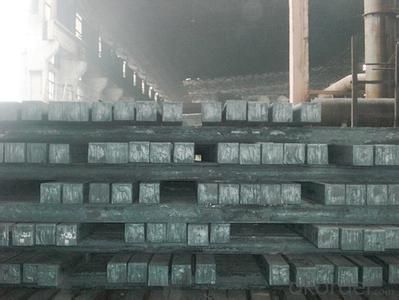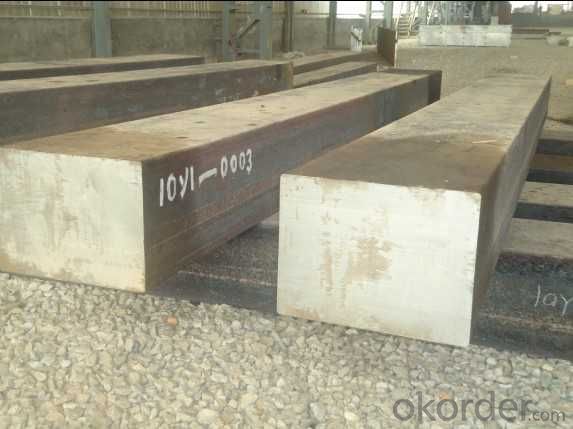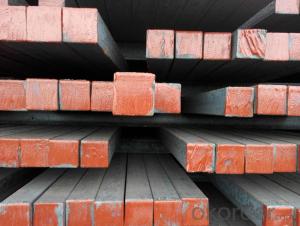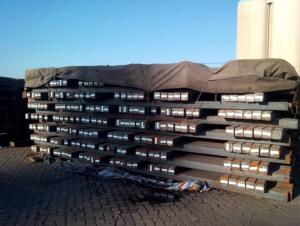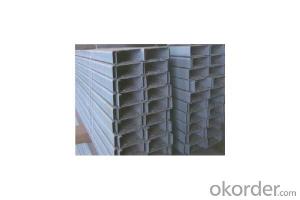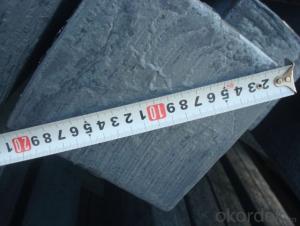Hot rolled Steel Square Billets Q195 and Q235 with High Quality for Construction
- Loading Port:
- China main port
- Payment Terms:
- TT or LC
- Min Order Qty:
- 25000 m.t.
- Supply Capability:
- 200000 m.t./month
OKorder Service Pledge
OKorder Financial Service
You Might Also Like
Specification of Hot rolled Steel Square Billets Q195 and Q235 with High Quality for Construction:
Chemical Composition. Q195
Standard | Grade | Element (%) | ||||
GB | Q195 | C | Mn | S | P | Si |
0.06~0.12 | 0.25~0.50 | ≤0.050 | ≤0.045 | ≤0.30 | ||
Chemical Composition. Q235
Standard | Grade | Element (%) | ||||
GB | Q235B | C | Mn | S | P | Si |
0.12~0.20 | 0.30~0.70 | ≤0.045 | ≤0.045 | ≤0.30 | ||
Technology process of Hot rolled Steel Square Billets Q195 and Q235 with High Quality for Construction:
1.Heat the EVA film
2.Cover the heated EVA film on the mould(can be made from wood or aluminum)
3.Spray a coating in a certain baume degree
4.Put on the empty blask
5.Sand-up the flask and vibrate to compaction
Packaging & Delivery of Hot rolled Steel Square Billets Q195 and Q235 with High Quality for Construction:
Packaging Details:containers
Delivery Detail:Complete one set of equipment needs for three months
The products can be delivered by bulk vessel or by container. As for container, products with the length of 6m will be loaded in 20’ container, with 9m or 12m, in 40’ container.
-The maximum quantity of loading of container is 25 tons.
-The products usually are transported to the nearest port from the production place.
FAQ:
Q1: How soon can we receive the product after purchase?
A1: Within three days of placing an order, we will begin production. The specific shipping date is dependent upon international and government factors, but is typically 7 to 10 workdays.
Q2: What makes stainless steel stainless?
A2: Stainless steel must contain at least 10.5 % chromium. It is this element that reacts with the oxygen in the air to form a complex chrome-oxide surface layer that is invisible but strong enough to prevent further oxygen from "staining" (rusting) the surface. Higher levels of chromium and the addition of other alloying elements such as nickel and molybdenum enhance this surface layer and improve the corrosion resistance of the stainless material.
Q3: Can stainless steel rust?
A3: Stainless does not "rust" as you think of regular steel rusting with a red oxide on the surface that flakes off. If you see red rust it is probably due to some iron particles that have contaminated the surface of the stainless steel and it is these iron particles that are rusting. Look at the source of the rusting and see if you can remove it from the surface.
Images:
- Q: What are the different types of steel billet surface treatments?
- There are several different types of steel billet surface treatments, including pickling, shot blasting, and painting. Pickling involves removing impurities and oxides from the surface of the billet using an acid solution. Shot blasting is a process in which small metallic or abrasive particles are blasted onto the surface of the billet to remove rust, scale, and other contaminants. Painting involves applying a protective coating or layer of paint to the surface of the billet to prevent corrosion and improve its appearance.
- Q: How are steel billets used in the manufacturing of pressure vessels?
- Steel billets are used in the manufacturing of pressure vessels as they serve as the raw material for shaping and forming various components such as plates, shells, and heads. These billets are heated and then hot rolled or forged into the desired shape, providing the necessary strength and durability required for pressure vessel construction.
- Q: How is the market for steel billets influenced by global economic trends?
- The market for steel billets is greatly influenced by global economic trends. As steel is a crucial raw material for various industries such as construction, automotive, and manufacturing, any fluctuations in the global economy can have a significant impact on the demand and pricing of steel billets. During times of economic growth, there is typically an increased demand for steel products, including steel billets, as construction projects and infrastructure development thrive. This heightened demand is often driven by increased consumer spending, rising urbanization, and government investments in infrastructure. Consequently, global economic trends, such as GDP growth, industrial production, and construction activity, play a vital role in determining the demand for steel billets. On the other hand, during economic downturns or periods of recession, the demand for steel billets tends to decline. Reduced consumer spending, decreased construction projects, and a slowdown in manufacturing all contribute to a decrease in steel billet demand. Global economic indicators, such as GDP contraction, industrial output decline, and reduced investment in infrastructure, can negatively impact the market for steel billets. Additionally, the market for steel billets is also influenced by global trade policies and international trade tensions. Tariffs, quotas, and trade disputes between countries can disrupt the supply chain of steel billets, leading to price volatility and market uncertainty. Protectionist measures or restrictions on steel imports can limit the availability of steel billets in certain regions, affecting market dynamics and pricing. Moreover, currency exchange rates also play a role in the market for steel billets. As steel is a traded commodity, fluctuations in currency values can influence the competitiveness of steel billet exports and imports. A strong domestic currency may make exports more expensive, reducing demand for steel billets in foreign markets, while a weak currency may make imports more expensive, potentially boosting demand for domestically produced steel billets. In conclusion, the market for steel billets is intricately linked to global economic trends. Economic growth, industrial production, construction activity, international trade policies, and currency exchange rates all impact the demand, supply, and pricing of steel billets. Monitoring and understanding these global economic trends is crucial for stakeholders in the steel industry to make informed decisions and navigate market fluctuations effectively.
- Q: What is the drop per minute of the billet temperature at 850?
- Cold rolling is not considered. The initial rolling temperature (surface) of the billet is generally 1000-1150 degrees.
- Q: What is the typical density of a steel billet?
- The typical density of a steel billet is approximately 7.8 grams per cubic centimeter (g/cm³).
- Q: What is the global production capacity of steel billets?
- The global production capacity of steel billets is difficult to estimate accurately as it varies from year to year and is influenced by factors such as market demand, economic conditions, and technological advancements. However, according to the World Steel Association, the total global production capacity for steel billets was approximately 1.86 billion metric tons in 2019. This capacity is spread across various countries and steel-producing regions, with China being the largest producer followed by India, Japan, and the United States. It is important to note that these figures are subject to change as the steel industry continues to evolve and expand.
- Q: What are the potential defects or flaws in steel billets?
- There are several potential defects or flaws that can occur in steel billets, which can affect the quality and performance of the final product. Some of these defects include: 1. Surface defects: Steel billets can develop surface cracks, scales, or scratches during the manufacturing process. These defects can weaken the material and reduce its structural integrity. 2. Internal defects: Inclusions, such as non-metallic impurities or gas bubbles, can be present within the steel billets. These internal defects can cause localized weaknesses and reduce the overall strength of the material. 3. Segregation: Uneven distribution of alloying elements or impurities can lead to segregation, where certain areas of the billet have different chemical compositions. Segregation can result in inconsistent mechanical properties across the material and decrease its uniformity. 4. Central segregation: This defect occurs when there is a concentration of impurities or alloying elements in the central region of the billet, leading to a weaker core. Central segregation can cause structural failures and reduce the overall reliability of the steel billet. 5. Shrinkage cavities: During the solidification process, shrinkage cavities can form in the steel billet due to the contraction of the molten metal. These cavities can weaken the material and compromise its structural integrity. 6. Surface decarburization: Exposure to high temperatures or improper heat treatment can cause the surface of the steel billet to lose carbon content, resulting in surface decarburization. This defect can reduce the hardness and strength of the material. 7. Laminations: Laminations are thin, elongated voids or layers that can form parallel to the surface of the billet. These defects can weaken the material and make it prone to cracking or failure under stress. 8. Internal cracks: Internal cracks can occur due to improper cooling or handling of the billet during the manufacturing process. These cracks can compromise the structural integrity of the steel billet and potentially lead to catastrophic failure. It is important to detect and address these defects early on to ensure the quality and reliability of the steel billets. Various non-destructive testing techniques, such as ultrasonic testing or magnetic particle inspection, can be utilized to identify and mitigate these potential flaws.
- Q: How do steel billets contribute to the overall strength of a structure?
- Steel billets play a crucial role in contributing to the overall strength of a structure. These billets, which are essentially semi-finished forms of steel, are used as raw material in the production of various structural components. One of the primary reasons steel billets enhance the strength of a structure is due to the inherent properties of steel itself. Steel is known for its exceptional strength and durability, making it an ideal material for construction purposes. When steel billets are used in the manufacturing process, they provide a solid foundation for creating stronger structural elements. Steel billets are typically hot-rolled or forged to shape different structural components, such as beams, columns, and plates. During the manufacturing process, the steel is subjected to high temperatures and pressure, resulting in a refined grain structure. This refined grain structure enhances the strength and toughness of the steel, making it more resistant to deformation and structural failure. Moreover, steel billets can be further processed to achieve specific mechanical properties that are required for different structural applications. For example, the billets can undergo heat treatment processes such as quenching and tempering, which improve their hardness and toughness. This allows the steel to withstand higher loads and stresses, thereby contributing to the overall strength and stability of the structure. In addition to their inherent strength, steel billets also offer advantages in terms of versatility and design flexibility. They can be easily shaped into various sizes and dimensions, allowing engineers to create complex structural configurations. This versatility enables the optimization of the structural design, ensuring that the load-bearing capacity and overall strength of the structure are maximized. Furthermore, steel billets have excellent weldability, allowing them to be seamlessly joined with other steel components. This ensures the integrity and continuity of the structure, preventing weak points or potential failure zones. By creating a unified and interconnected system, the steel billets contribute to the overall strength and stability of the structure. In conclusion, steel billets make a significant contribution to the overall strength of a structure through their inherent strength, refined grain structure, and ability to undergo various heat treatment processes. They provide a solid foundation for manufacturing structural components, allowing them to withstand high loads and stresses. The versatility and design flexibility of steel billets further optimize the structural design, while their excellent weldability ensures the integrity of the structure. Consequently, steel billets are essential in creating robust and durable structures that can withstand the test of time.
- Q: After processing to the color coating board, is there a fare increase of 1000?The price of galvanized coil is about +350 per ton of cold-rolled steel at present What about the cost of billet to cold rolling?What is the final cost of making the color coated sheet? How do you figure that?
- I think that the cost of steel billet plus manual consumption plus electricity and other costs divided by the finished product is greater than the cost per ton
- Q: What are the different surface treatments for rust prevention in steel billets?
- There are several surface treatments available for rust prevention in steel billets. These treatments aim to protect the steel surface from corrosion caused by exposure to moisture or other corrosive elements. Some of the commonly used surface treatments include: 1. Hot-dip galvanizing: This process involves immersing the steel billets in a bath of molten zinc, which creates a protective layer on the surface. The zinc coating acts as a barrier against corrosion, preventing the steel from coming into contact with corrosive elements. 2. Electroplating: In this method, a thin layer of a corrosion-resistant metal, such as zinc, nickel, or chromium, is deposited onto the steel billet surface using an electric current. The electroplated layer provides a protective barrier against rust formation. 3. Paint coatings: Applying a layer of paint on the steel billet surface can effectively prevent rust. The paint forms a protective barrier, preventing moisture or corrosive substances from reaching the steel surface. Multiple layers of paint, including primer and topcoat, are typically applied to enhance durability. 4. Powder coating: This process involves applying a dry powder, usually made of epoxy, polyester, or acrylic, to the steel billet surface. The powder is electrostatically charged and adheres to the metal, forming a protective coating when heated. Powder coating provides excellent corrosion resistance and durability. 5. Phosphating: Phosphating is a chemical treatment method that involves applying a phosphate coating to the steel surface. The phosphate layer enhances the steel's resistance to corrosion and provides a good base for subsequent paint or powder coating. 6. VCI (Vapor Corrosion Inhibitor) packaging: This method utilizes special packaging materials that release volatile corrosion inhibitors. These inhibitors create a protective atmosphere around the steel billets, preventing rust formation during storage or transportation. It is important to note that the choice of surface treatment depends on factors such as the steel's intended application, environment, and cost considerations. Each treatment method has its advantages and limitations, and it is essential to select the most appropriate treatment for effective rust prevention in steel billets.
Send your message to us
Hot rolled Steel Square Billets Q195 and Q235 with High Quality for Construction
- Loading Port:
- China main port
- Payment Terms:
- TT or LC
- Min Order Qty:
- 25000 m.t.
- Supply Capability:
- 200000 m.t./month
OKorder Service Pledge
OKorder Financial Service
Similar products
Hot products
Hot Searches
Related keywords

